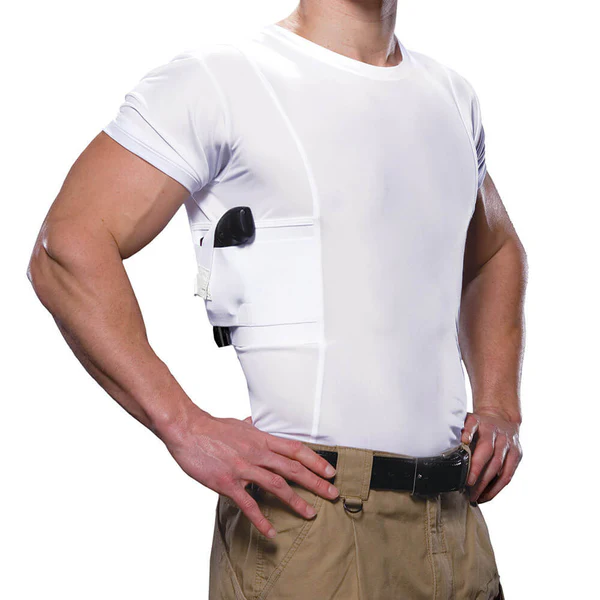
Key Takeaways
- Choose clothing options that empower comfortable, practical, and secure concealed carry, allowing for confident movement and low visibility.
- Prioritize firearm safety through disciplined handling, routine checks, and a deep understanding of trusted safety routines.
- Keep current with concealed carry regulations for your state and locality to avoid unintentional violations and ensure peace of mind.
- Adapt your carry methods to various daily environments, from work to recreation, so concealment remains effortless and effective in all situations.
Comfort Is Key: Choosing Concealed Carry Clothing
Comfort and discretion are both essential to daily concealed carry, but striking that balance isn’t always easy. Many people turn to holster shirts for concealed carry, a smart option that securely holds a firearm while maintaining a low profile beneath everyday clothes. Concealed carry garments are popular due to their ability to disperse firearm weight, reduce bulges, and allow for natural movement. These garments are designed to integrate seamlessly into your lifestyle, making them suitable for a variety of activities. The choice of attire depends on your wardrobe and body type, with loose shirts providing better concealment and firmer fits offering greater comfort. Fabrics should be lightweight and moisture-wicking, and a soft inner lining prevents skin irritation. Practice drawing your firearm in front of a mirror to identify printing or mobility issues before leaving.
The Foundation of Concealment: Safety First
Concealed carry is crucial for both safety and security. Responsible firearm owners should follow fundamental safety rules, such as treating every gun as if it were loaded, keeping their fingers off the trigger, and being aware of the muzzle direction at all times. Industry data indicate that most accidental discharges and injuries can be prevented by adhering to these guidelines. Regular safety checks should include securely holstering the firearm, inspecting gear for signs of wear or damage, and practicing with unloaded guns. Rehearsing “what-if” scenarios can also help reinforce these habits. By implementing these safety habits, individuals not only protect themselves but also contribute to safer communities.
Understanding the Legal Landscape
Carrying a concealed firearm requires a thorough understanding of constantly changing laws. Each state and city has unique regulations defining where, who, and what types of weapons can be carried. These laws can vary within short distances, making it crucial to stay informed about these changes. Legal handbooks and website databases can help with this. Researching new destinations, especially if traveling, is essential. Some states require specific signage or documentation, while others operate under permitless carry laws. When in doubt, contact your local law enforcement agency or consult trusted online guides. Maintaining legal awareness minimizes risks and demonstrates a responsible approach to business operations.
Confidence Through Training
Concealed carry training is crucial for the effective and responsible use of firearms. It goes beyond basic law requirements, focusing on scenario-based drills, safe movement, tactical decision-making, and mindset. More Americans are seeking personalized instruction to refine their skills and stay current with the latest best practices. This investment in education leads to increased confidence and improved reaction time under stress. Regular range time, dry-fire practice, and refresher courses reinforce these lessons. Training while wearing everyday concealed carry clothing and holsters helps identify limitations and ensures smooth operation under duress. Seeking feedback from experienced instructors and continually pushing oneself to improve are essential for growth. The goal is to be prepared, confident, and in control in decisive situations.
Balancing Discretion and Accessibility
Concealed carry and quick accessibility can be achieved with careful planning. Holster choice is crucial, with options including appendix, inside-the-waistband (IWB), and shoulder holsters, each offering unique advantages. Appendix carry is best for rapid access and concealment but may be uncomfortable for individuals with certain body types or those engaging in specific activities. IWB holsters are highly discreet and adaptable, accommodating various clothing styles for full-day wear. Shoulder holsters are great for layering but less practical in minimal clothing setups. Testing combinations and practicing with mirrors or phone cameras can help refine your drawing skills. Effective concealed carriers prioritize anonymity and readiness, continually reassessing their setup as seasons or circumstances change.
Final Thoughts: Making Concealed Carry Work for You
Concealed carry is not just a technical skill; it’s a daily practice for comfort, safety, legality, and responsibility. With the evolution of clothing and equipment options, carriers can benefit from increased customization. Knowledge, adaptability, and self-improvement enable responsible carriers to integrate concealed carry into their lives, making it a natural part of personal security and peace of mind.

